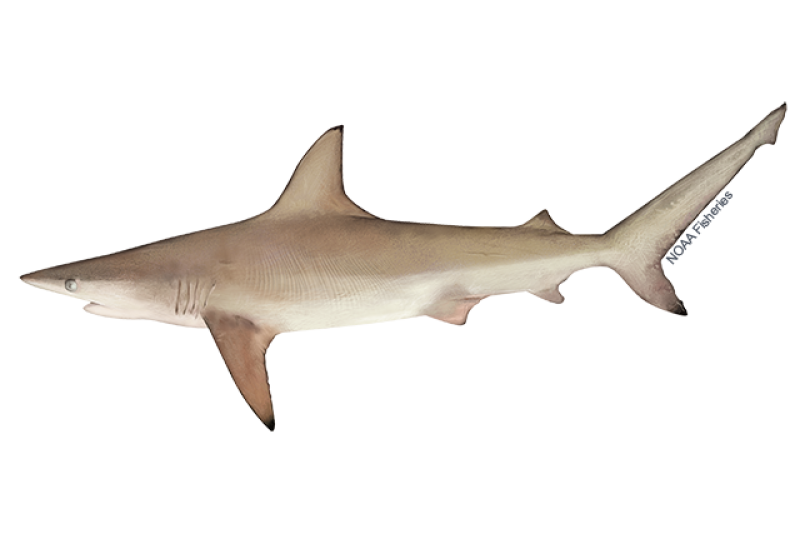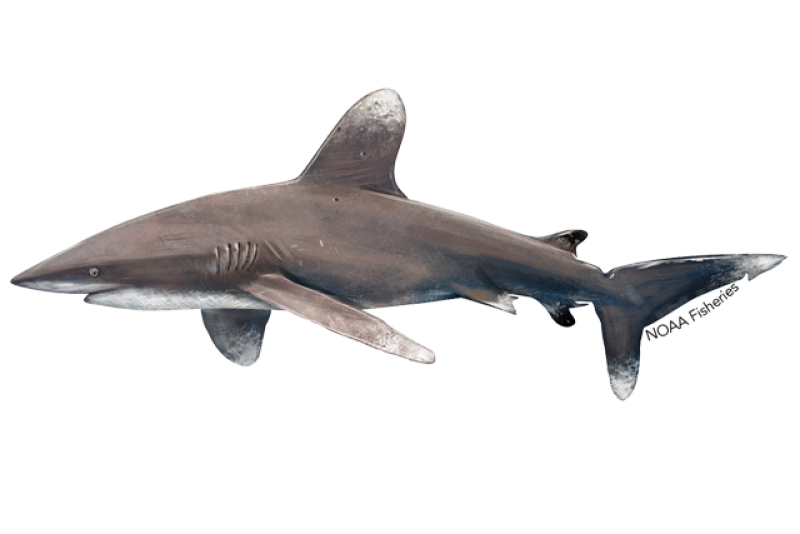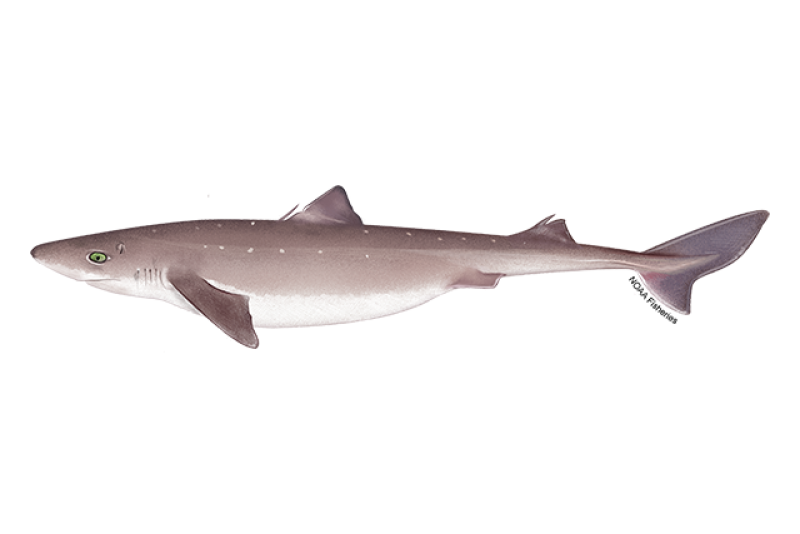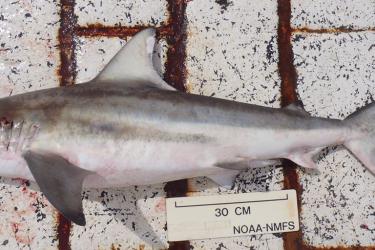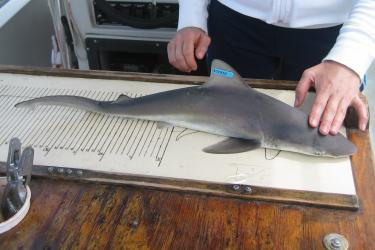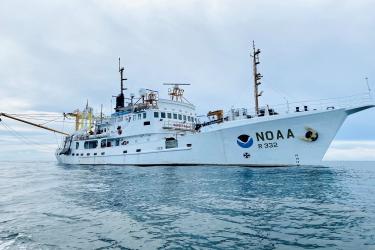 Atlantic blacktip shark. Credit: Shutterstock
Atlantic blacktip shark. Credit: Shutterstock
Atlantic blacktip shark. Credit: Shutterstock
About the Species
 Atlantic blacktip shark. Credit: Shutterstock
Atlantic blacktip shark. Credit: Shutterstock
Atlantic blacktip shark. Credit: Shutterstock
U.S. wild-caught Atlantic blacktip shark is a smart seafood choice because it is sustainably managed and responsibly harvested under U.S. regulations.

Population
The stocks are not overfished.

Fishing Rate
Not subject to overfishing.

Habitat Impact
Gear used to catch blacktip sharks has minimal impact on habitat.

Bycatch
Regulations are in place to minimize bycatch.
Population Status
- There are two stocks of blacktip shark: Atlantic and Gulf of America* (formerly Gulf of Mexico). According to the most recent stock assessments:
- The Atlantic stock is not overfished and not subject to overfishing (2021 stock assessment). Summary stock assessment information can be found on Stock SMART.
- The Gulf of America stock is not overfished and not subject to overfishing (2018 stock assessment). Summary stock assessment information can be found on Stock SMART.
Appearance
- Atlantic blacktip sharks are gray to gray-brown, with white on the belly and a conspicuous wedge-shaped band or Z-shaped line on the sides.
- Their pectoral, dorsal, and tail fins have black tips, but the anal fin is white.
- Their bodies have a torpedo shape, which allows them to swim through the water with little effort.
- Atlantic blacktip sharks are often confused with spinner sharks due to their similar size, shape, coloration, and behavior. Both species are known for leaping and spinning out of the water while feeding on schools of fish. A distinguishing feature is that the anal fin on the blacktip shark is white whereas the anal fin of the spinner shark has a black tip.
Biology
- Atlantic blacktip sharks grow quickly, and can reach up to 6 feet in length. The oldest observed blacktip shark was 15.5 years old.
- They often form large groups, segregated into separate schools of males and females when they are not mating. They mate between March and June.
- Males mature at 4 to 5 years of age, while females mature later, at 6 to 7 years of age.
- Females have an 11 to 12-month gestation period and give birth to an average of three pups per litter in the Atlantic and four to five pups per litter in the Gulf of America.
- Pups are born in shallow nursery grounds away from the adult population. After giving birth, the females leave the nursery area while juveniles remain.
- Blacktip sharks eat bony fishes, smaller sharks, squids, stingrays, shrimp, and crabs. They often follow fishing boats and are sometimes seen consuming discarded fish.
Where They Live
Range
- Atlantic blacktip sharks can be found year-round in the Gulf of America and are common from Virginia through Florida.
- They have been known to migrate as far north as Cape Cod, Massachusetts.
Habitat
- The Atlantic blacktip shark is primarily a continental shelf species.
- They’re commonly found off beaches, in bays, estuaries, over coral reefs, and off river mouths. They can also be found around some oceanic islands.
Fishery Management
- NOAA Fisheries and the Atlantic Highly Migratory Species Division manage the Atlantic blacktip shark fishery.
- Managed under the Consolidated Highly Migratory Species Fishery Management Plan:
- Permits are required, and only a limited number of permits are available.
- Commercial quotas and limits on how many sharks can be landed per fishing trip.
- Gear restrictions and requirements
- Fishing season is generally year-round, but individual commercial shark fisheries close when the quota is reached.
- Shark dealers are required to attend Atlantic shark identification workshops to help them better identify shark species.
- Prohibited species—there are more than 20 species of sharks that cannot be landed (e.g., white, dusky, basking, longfin mako, night). Some of these species look similar to the species that can be landed. Atlantic shark identification workshops can help with identification.
- The Shark Conservation Act requires that all sharks, with one exception, be brought to shore with their fins naturally attached.
- Compliance guides are available for all commercial and recreational regulations across Atlantic highly migratory species fisheries.
- Unlike some highly migratory shark species, there is no international management for Atlantic blacktip sharks at this time.
Harvest
- Commercial fishery:
- To commercially harvest Atlantic sharks, vessel owners must obtain a valid Atlantic shark directed or incidental limited access permit or a smoothhound shark open access permit. More information regarding limited access permits can be found in the Atlantic HMS commercial compliance guide.
- Atlantic blacktip sharks belong to the large coastal shark complex.
- Gear types, habitat impacts, and bycatch:
- Bottom longlines and gillnets are used to catch Atlantic blacktip sharks.
- Gear used to catch blacktip sharks may catch other species, including marine mammals and turtles.
- Fishermen using bottom longline or gillnet gear must complete a protected species safe handling, release, and identification workshop.
- Certain areas are closed to shark fishing to protect nursery areas, sensitive habitats, and populations.
- Vessel monitoring systems ensure fishermen are complying with area closures.
- To reduce bycatch of fish, including Atlantic blacktip sharks, shrimp trawlers are required to use bycatch reduction devices, which are designed to retain shrimp but allow fish to exit the net.
- Recreational fishery:
- Recreational fishermen typically use rod-and-reel gear for blacktip sharks:
- Recreational fishermen must have an Atlantic HMS permit to harvest Atlantic blacktip sharks in federal waters. As of January 1, 2018, all HMS recreational permit holders will need a “shark endorsement” to fish for, retain, possess, or land sharks.
- Fishermen fishing recreationally for sharks will be required to use circle hook in most places. For more information regarding these requirements, please refer to HMS regulations and the Amendment 5b compliance guide.
- Blacktip sharks are a popular recreational species because they are found near shore and often jump and spin out of the water.
*Executive Order 14172, “Restoring Names That Honor American Greatness” (Jan. 20, 2025), directs that the Gulf of Mexico be renamed the Gulf of America. Gulf of America references in this website refer to the same area as the Gulf of Mexico in the applicable regulations under 50 CFR parts 216–219, 222–226, and 600–699. The name change did not result in any changes to, and had no effect on the applicability or enforceability of, any existing regulations. This website continues to use “Gulf of Mexico” when quoting statutes, existing regulations, or previously published materials.
Scientific Classification
- Atlantic blacktip sharks can be found year-round in the Gulf of America and are common from Virginia through Florida.
- They have been known to migrate as far north as Cape Cod, Massachusetts.
- The Atlantic blacktip shark is primarily a continental shelf species.
- They’re commonly found off beaches, in bays, estuaries, over coral reefs, and off river mouths. They can also be found around some oceanic islands.
Fishery Management
- NOAA Fisheries and the Atlantic Highly Migratory Species Division manage the Atlantic blacktip shark fishery.
- Managed under the Consolidated Highly Migratory Species Fishery Management Plan:
- Permits are required, and only a limited number of permits are available.
- Commercial quotas and limits on how many sharks can be landed per fishing trip.
- Gear restrictions and requirements
- Fishing season is generally year-round, but individual commercial shark fisheries close when the quota is reached.
- Shark dealers are required to attend Atlantic shark identification workshops to help them better identify shark species.
- Prohibited species—there are more than 20 species of sharks that cannot be landed (e.g., white, dusky, basking, longfin mako, night). Some of these species look similar to the species that can be landed. Atlantic shark identification workshops can help with identification.
- The Shark Conservation Act requires that all sharks, with one exception, be brought to shore with their fins naturally attached.
- Compliance guides are available for all commercial and recreational regulations across Atlantic highly migratory species fisheries.
- Unlike some highly migratory shark species, there is no international management for Atlantic blacktip sharks at this time.
Harvest
- Commercial fishery:
- To commercially harvest Atlantic sharks, vessel owners must obtain a valid Atlantic shark directed or incidental limited access permit or a smoothhound shark open access permit. More information regarding limited access permits can be found in the Atlantic HMS commercial compliance guide.
- Atlantic blacktip sharks belong to the large coastal shark complex.
- Gear types, habitat impacts, and bycatch:
- Bottom longlines and gillnets are used to catch Atlantic blacktip sharks.
- Gear used to catch blacktip sharks may catch other species, including marine mammals and turtles.
- Fishermen using bottom longline or gillnet gear must complete a protected species safe handling, release, and identification workshop.
- Certain areas are closed to shark fishing to protect nursery areas, sensitive habitats, and populations.
- Vessel monitoring systems ensure fishermen are complying with area closures.
- To reduce bycatch of fish, including Atlantic blacktip sharks, shrimp trawlers are required to use bycatch reduction devices, which are designed to retain shrimp but allow fish to exit the net.
- Recreational fishery:
- Recreational fishermen typically use rod-and-reel gear for blacktip sharks:
- Recreational fishermen must have an Atlantic HMS permit to harvest Atlantic blacktip sharks in federal waters. As of January 1, 2018, all HMS recreational permit holders will need a “shark endorsement” to fish for, retain, possess, or land sharks.
- Fishermen fishing recreationally for sharks will be required to use circle hook in most places. For more information regarding these requirements, please refer to HMS regulations and the Amendment 5b compliance guide.
- Blacktip sharks are a popular recreational species because they are found near shore and often jump and spin out of the water.
*Executive Order 14172, “Restoring Names That Honor American Greatness” (Jan. 20, 2025), directs that the Gulf of Mexico be renamed the Gulf of America. Gulf of America references in this website refer to the same area as the Gulf of Mexico in the applicable regulations under 50 CFR parts 216–219, 222–226, and 600–699. The name change did not result in any changes to, and had no effect on the applicability or enforceability of, any existing regulations. This website continues to use “Gulf of Mexico” when quoting statutes, existing regulations, or previously published materials.
Scientific Classification
| Kingdom | Animalia | Phylum | Chordata | Class | Chondrichthyes | Order | Carcharhiniformes | Family | Carcharhinidae | Genus | Carcharhinus | Species | limbatus |
|---|
Last updated by NOAA Fisheries on 05/22/2025
Featured News
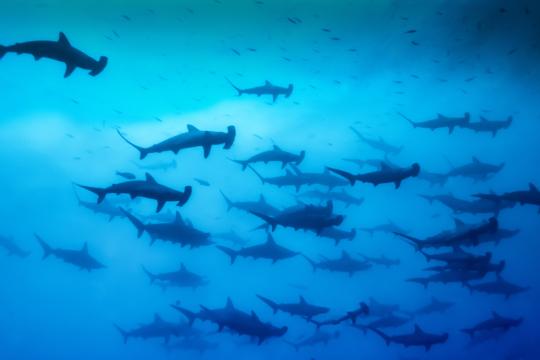
Global Extinction Risk for Sharks and Rays Is High, United States may Provide Haven
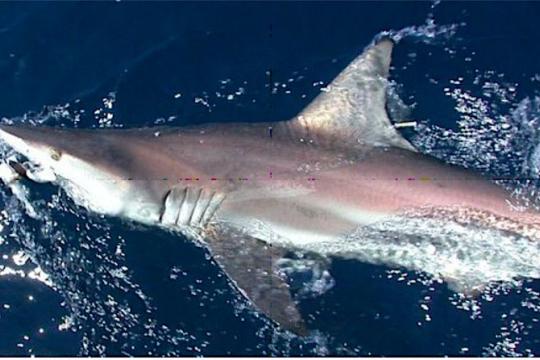 Blacktip shark with a dart tag at the base of its first dorsal fin. Credit: NOAA Fisheries
Blacktip shark with a dart tag at the base of its first dorsal fin. Credit: NOAA Fisheries
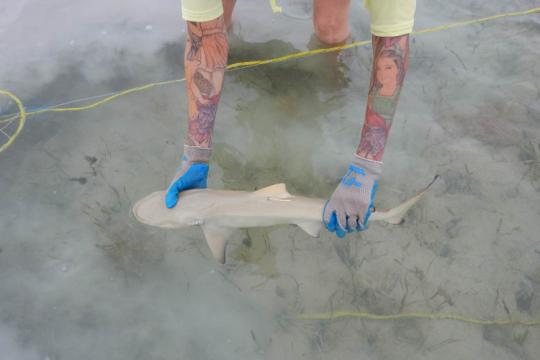 Previously tagged lemon shark Negaprion acutidens recaptured during survey
Previously tagged lemon shark Negaprion acutidens recaptured during survey

Seafood Facts

Is Atlantic Blacktip Shark Sustainable?
U.S. wild-caught Atlantic blacktip shark is a smart seafood choice because it is sustainably managed and responsibly harvested under U.S. regulations.
Availability
Availability varies because the fishery is open periodically throughout the year and closes when the quota is reached.
Source
U.S. wild caught from New England to Florida and in the Gulf of America (formerly Gulf of Mexico).
Taste
Sweet, meaty taste.
Texture
Thick, large flakes and moist flesh.
Color
Pinkish-white meat with ruby red edges.
Health Benefits
Shark is a low-fat source of protein and is high in selenium and vitamins B6 and B12.
Nutrition Facts
Servings: 1; Serving Weight: 100 g (raw); Calories: 130; Protein: 21 g; Total Fat: 5 g; Total Saturated Fatty Acids: 1 g; Carbohydrate: 0 g; Total Sugars: 0 g; Total Dietary Fiber: 0 g; Cholesterol: 51 mg; Selenium: 36.5 mcg; Sodium: 79 mgMore Information
Last updated by NOAA Fisheries on 05/22/2025
Seafood News
 Celebrate Culinary Arts Month with a sustainable seafood recipe for every month of the year.
Celebrate Culinary Arts Month with a sustainable seafood recipe for every month of the year.
What Your Birth Month Says About Your Next Seafood Recipe
 Fresh-caught taʻape on ice. Credit: Conservation International Hawaiʻi.
Fresh-caught taʻape on ice. Credit: Conservation International Hawaiʻi.
Reducing Waste and Feeding Communities in Hawaiʻi with a Whole Fish Approach
 Chef Tyler Hadfield’s Curried Skate Wings with Tomato-Masala Chutney
Chef Tyler Hadfield’s Curried Skate Wings with Tomato-Masala Chutney
Ring In the New Year With These Crowd-Favorite Seafood Recipes
 NOAA Fisheries, in collaboration with Blue Ocean Mariculture, is conducting a multi-year pilot study to evaluate observational methods and tools for studying Hawaiian monk seal behavior. Courtesy of Blue Ocean Mariculture
NOAA Fisheries, in collaboration with Blue Ocean Mariculture, is conducting a multi-year pilot study to evaluate observational methods and tools for studying Hawaiian monk seal behavior. Courtesy of Blue Ocean Mariculture
AI Meets Aquaculture to Study Hawaiian Monk Seal Interactions With Net Pens
Science Overview
NOAA Fisheries conducts shark research from New England and the Mid-Atlantic to the South Atlantic and Gulf of America (formerly Gulf of Mexico), studying shark life history and performing long-term monitoring activities essential for stock assessment and management.
For detailed information about stock status, management, assessments, and resource trends, you can search for Atlantic blacktip shark, and any other species of interest, using NOAA's StockSMART web tool.
Tagging and Tracking Blacktip Sharks
NOAA Fisheries runs the Cooperative Shark Tagging Program to study the life history of Atlantic sharks. Started in 1962, the program involves thousands of recreational and commercial fishermen, scientists, and fisheries observers. Participants tag large coastal and pelagic sharks and record information about the shark, such as the date and location where caught, gear used, and the size and sex of the shark.
Last updated by NOAA Fisheries on 05/22/2025
Documents
Characterization of the Shark Bottom Longline Fishery: 2017
Alyssa N. Mathers, Bethany M. Deacy, Heather E. Moncrief-Cox, John K. Carlson
Characterization of the Shark Bottom Longline Fishery: 2015
Michael P. Enzenauer, Bethany M. Deacy, John K. Carlson
Characterization of the Shark Bottom Longline Fishery: 2014
Michael P. Enzenauer, Bethany M. Deacy, John K. Carlson
Characterization of the Shark Bottom Longline Fishery: 2013
Characterization of the Shark Bottom Longline Fishery: 2013
Research
Northeast Shark Research
We conduct shark life history research and long-term monitoring activities essential for stock assessment and management.
Last updated by NOAA Fisheries on 05/22/2025
